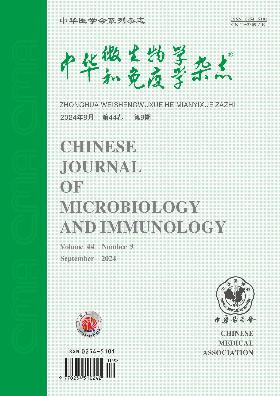实时RT-PCR检测严重急性呼吸系统综合征冠状病毒2型核酸
Q4 Immunology and Microbiology
引用次数: 2
摘要
目的探讨实时RT-PCR检测SARS-CoV-2核酸在COVID-2019临床诊断中的应用价值。方法收集截至2020年3月5日中国传染病信息系统中河南省新冠肺炎病例的实验室检测数据和病例基本信息。所有信息均由当地医院和疾病控制与预防中心(CDC)输入。当地医院或国家疾控中心负责抽样,市疾控中心负责核酸检测。结果共检出标本6 714份,SARS-CoV-2核酸阳性率为23.82%。采集的标本来自1 200例确诊病例、2 178例疑似病例和77例无症状病例。新型冠状病毒核酸诊断率为36.96%(1 277/3 455)。鼻拭子、痰和咽拭子中SARS-CoV-2核酸阳性率分别为19.38%、28.59%和23.53% (χ2=15.896, P<0.01)。确诊病例中SARS-CoV-2核酸阳性率为63.10%。鼻拭子、痰液和咽拭子的阳性率分别为50.80%、58.71%和65.21% (χ2=18.612, P<0.01)。发病当天及发病后1周、2周、3周、4周、5周及5周以上标本中SARS-CoV-2核酸阳性率分别为43.51%、23.98%、22.82%、12.17%、14.46%和13.21%。确诊病例阳性率分别为89.03%、86.57%、52.30%、17.53%、17.69%和24.14%。结论实时RT-PCR是COVID-19早期病原诊断最有效的方法。核酸检出率在发病后1周内达到最高,最晚核酸检测时间为发病后38 d。关键词:SARS-CoV-2;COVID-19;实时rt - pcr本文章由计算机程序翻译,如有差异,请以英文原文为准。
Real-time RT-PCR for the detection of SARS-CoV-2 nucleic acid
Objective
To investigate the performance of real-time RT-PCR for the detection of SARS-CoV-2 nucleic acid in clinical diagnosis of COVID-2019.
Methods
Laboratory test data and basic case information of Henan COVID-19 cases were collected from the China's Infectious Disease Information System as of March 5, 2020. All information was entered by local hospitals and Center for Disease Control and Prevention (CDC). Local hospitals or country CDC were responsible for sampling and municipal CDC was responsible for nucleic acid testing.
Results
A total of 6 714 specimens were detected and the positive rate of SARS-CoV-2 nucleic acid was 23.82%. The specimens were collected from 1 200 confirmed cases, 2 178 suspected cases and 77 asymptomatic cases. The nucleic acid diagnosis rate of COVID-19 was 36.96% (1 277/3 455). In all cases, the positive rates of SARS-CoV-2 nucleic acid in nasal swabs, sputum samples and throat swabs were 19.38%, 28.59% and 23.53%, respectively (χ2=15.896, P<0.01). The positive rate of SARS-CoV-2 nucleic acid in confirmed COVID-19 cases was 63.10%. The positive rates in nasal swabs, sputum samples and throat swabs were 50.80%, 58.71% and 65.21 (χ2=18.612, P<0.01). The positive rates of SARS-CoV-2 nucleic acid were 43.51%, 23.98%, 22.82%, 12.17%, 14.46% and 13.21% in samples collected on the day of symptom onset and one week, two weeks, three weeks, four weeks, five weeks and above five weeks after the onset, respectively. The positive rates in confirmed cases were respectively 89.03%, 86.57%, 52.30%, 17.53%, 17.69% and 24.14% at those time points.
Conclusions
Real-time RT-PCR is the most effective method for early pathogenic diagnosis of COVID-19. The highest detection rate of nucleic acid is achieved within one week after the onset of COVID-19, and the latest time for nucleic acid detection is 38 d after the onset.
Key words:
SARS-CoV-2; COVID-19; Real-time RT-PCR
求助全文
通过发布文献求助,成功后即可免费获取论文全文。
去求助
来源期刊

中华微生物学和免疫学杂志
Immunology and Microbiology-Virology
CiteScore
0.50
自引率
0.00%
发文量
6906
期刊介绍:
Chinese Journal of Microbiology and Immunology established in 1981. It is one of the series of journal sponsored by Chinese Medical Association. The aim of this journal is to spread and exchange the scientific achievements and practical experience in order to promote the development of medical microbiology and immunology. Its main contents comprise academic thesis, brief reports, reviews, summaries, news of meetings, book reviews and trends of home and abroad in this field. The distinguishing feature of the journal is to give the priority to the reports on the research of basic theory, and take account of the reports on clinical and practical skills.
 求助内容:
求助内容: 应助结果提醒方式:
应助结果提醒方式:


